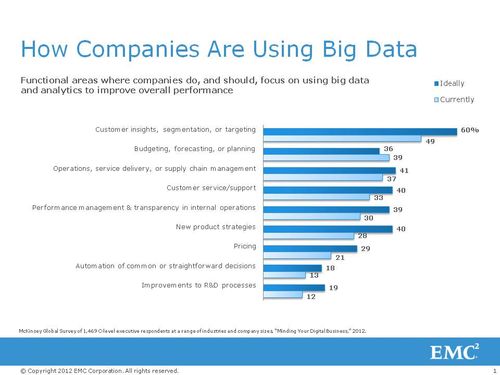Big Data — not since the “Cloud” – EMC’s CMO Jeremy Burton has noted — has there been a term that meant so little to so many. That’s not to say that it hasn’t been defined. In fact, when you Google it, you get 1.5 million results back in .27 seconds. Not surprising, and depending on the day, EMC, IBM, Oracle, SAS, present the searcher with myriad definitions. Wikipedia, for example, states that “Big Data” is a “term applied to data sets whose size is beyond the ability of commonly used software tools to capture, manage, and process the data within a tolerable elapsed time…” Others use the three V’s to distinguish it: Volume, Variety, and Velocity. I know some Data Scientists who, not surprisingly, feel the definition of Big Data can be best formulated when it is characterized with implications: Large Volumes, New Sources, and Low Latencies create New Platforms, New Roles, and New Techniques.
Of course there’s no better way to achieve some clarity on the subject than through use-case scenarios.
So, as the VP of marketing for Greenplum, I thought it would be interesting to take a stroll through “marketing” oriented companies, and find out what the term Big Data means to them and how it is transforming their business. Fortunately, I was able to tap into the Greenplum customer database and pull some interesting Big Data stories for three Digital Marketing Media companies – Havas Digital, Knotice, and Media Mind. I found a common thread among these companies that provide Big Data Analytics for Marketing Departments across Fortune 1000 companies – Big Data ultimately means delivering better Marketing ROI.
What does Big Data mean to Havas Digital? Katrin Riban, EVP of Data Platforms at Havas Digital says:
“Data becomes Big Data once you start worrying about performance more than you’re worrying about consistency of your data warehouse and your operations, etc. Once you start obsessing about, will I be able to do tomorrow what I do today, even if my dataset grows twofold, threefold, fivefold, tenfold, then – then you start dealing with Big Data.”
What drove Havas to Big Data was the “need to provide attribution for our clients’ marketing efforts and to understand what was really driving the results that our clients expected from marketing.” Riban typically uses the example of if you were exposed to a video and then searched for it on Google, which one of these two exposures has really helped you find the product that you needed to find? Classically, in digital marketing, you will attribute it to the last exposure, but obviously that isn’t correct. So you need sophisticated methodologies to be able to spread credit for the sales across those exposures.
Clearly, one of the major benefits or transformations here is that Havas’ customers reach higher ROIs through Big Data analytics. Riban confirms this with an example of a customer in the travel sector. She states “We’ve been able to improve the ROI by 300%, which is absolutely amazing for the travel sector in the UK, because it’s one of the most competitive sectors in the world for paid search. And by using attribution, we’ve been able to have 300% more ROI with 27% more sales.”
And when talking about ROI, Jeff Carey, Director of Analysis and Strategy at Knotice points out that Big Data, especially incarnated as a real-time analytical engine, could optimize marketing campaigns, as well as optimize content across all digital channels. Carey says:
“For an example of how Big Data has benefited our clients during the holiday timeframe, think about Cyber Monday and Black Friday and all of the super aggressive offers out in the marketplace. One of our clients targeted direct display messages out to their current subscribers, as well as to their prospects. By having tailored messages off of this data, they saw 7x the conversion rates on their direct-to-direct display advertising during that timeframe.”
When I was at the Data Science Summit, I happened to be sitting with Ron Serig from Media Mind for lunch and asked him what the term Big Data means to him. Simply put, “Big Data for me is about data sets that are too big for an organization to handle with traditional tools.” With website traffic data doubling every year, Media Mind needed the ability to handle this amount of data and drive insights that couldn’t have been done before. For Serig, these insights are drawn from looking at the user across different channels.
“Once you have all the touch points of a user, either through a web browser on a computer or on a mobile phone, through Google search or any other search engine, the user has been exposed to ads. If you can record all those touch points, you can begin to understand the path to conversion, and get better ROI for the advertising campaign that we serve. I think that’s one of the biggest advantages that we can get.”
More Data + Real Time Analytics + Tailored Marketing = Higher ROI.
And that’s just exhibited in the Digital Marketing industry. When you start looking at other industries, there will be a different Big Data formula or definition around the following use cases:
- Retail: Customer scoring, Store locations and layout, fraud detection/prevention, supply chain optimization;
- Financial Services: Algorithmic trading, risk analysis, fraud detection, portfolio analysis;
- Manufacturing: Product research, engineering analytics, process & quality analysis, distribution analysis;
- Government: Market governance, counterterrorism, econometrics, health informatics;
- Advertising & Public Relations: Demand signaling, ad targeting, sentiment analysis, customer acquisition;
- Healthcare & Life Sciences: Pharmaco-Genomics, Bioinformatics, pharmaceutical research, clinical outcome research;
And this is just the beginning.
